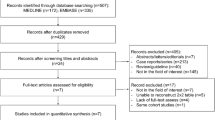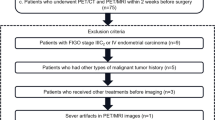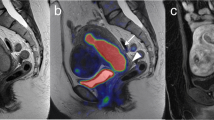Abstract
Purpose
The aim of this study is to test the hypothesis that positron emission tomography (PET) with 3′-deoxy-3′-[18F]-fluorothymidine (18F-FLT) can differentiate malignancy from benign leiomyoma better than PET with 2-deoxy-2-[18F]fluoro-d-glucose (18F-FDG), and to evaluate whether 18F-FLT and 18F-FDG uptake correlate with immunohistochemical index of cell proliferation.
Methods
The protocol of this prospective study was approved by the institutional ethics committee, and all patients gave written informed consent. Fifteen patients (aged 26–65 years, median 44 years) with uterine corpus tumor which has the possibility of being leiomyosarcoma underwent 18F-FLT and 18F-FDG PET scans. Maximum standard uptake value (SUVmax) of PET scans and Ki-67 labeling index of surgical specimens were evaluated. Mann–Whitney’s U test was used for comparing uptakes between benign and malignant, and linear regression analysis was used for evaluating the correlation between Ki-67 labeling index and SUVmax.
Results
Five cases were diagnosed as malignant (leiomyosarcoma for 3 cases, and carcinoma for 2 cases), and the others were benign leiomyoma. Sensitivity and negative predictive value of both tracers for detecting malignancy was 100 %. Specificity, positive predictive value and accuracy of 18F-FLT PET were higher than those of 18F-FDG PET. Difference in SUVmax between malignant and benign was significant for 18F-FLT PET (P < 0.01), but not for 18F-FDG PET. While all the malignant cases showed positive uptake in both tracers, a case of leiomyosarcoma with huge necrosis showed relatively low uptake. Uptake of 18F-FLT showed better correlation with Ki-67 labeling index compared with 18F-FDG (R 2 = 0.91 vs. R 2 = 0.26).
Conclusion
Negative findings on additional 18F-FDG or 18F-FLT PET may rule out the possibility of malignancy for the patients with suspected leiomyosarcoma diagnosed by conventional methods. 18F-FLT PET is superior to 18F-FDG PET in differentiating malignant from benign leiomyoma. Moreover, 18F-FLT uptake correlated well with the immunohistochemical index of cell proliferation.






Similar content being viewed by others
References
Sahdev A, Sohaib SA, Jacobs I, Shepherd JH, Oram DH, Reznek RH. MR imaging of uterine sarcomas. AJR Am J Roentgenol. 2001;177:1307–11.
Grgic A, Yuksel Y, Groschel A, Schafers HJ, Sybrecht GW, Kirsch CM, et al. Risk stratification of solitary pulmonary nodules by means of PET using 18F-fluorodeoxyglucose and SUV quantification. Eur J Nucl Med Mol Imaging. 2010;37:1087–94.
Boland GW, Dwamena BA, Jagtiani Sangwaiya M, Goehler AG, Blake MA, Hahn PF, et al. Characterization of adrenal masses by using FDG PET: a systematic review and meta-analysis of diagnostic test performance. Radiology 2011;259:117–126.
Ozaki Y, Oguchi K, Hamano H, Arakura N, Muraki T, Kiyosawa K, et al. Differentiation of autoimmune pancreatitis from suspected pancreatic cancer by fluorine-18 fluorodeoxyglucose positron emission tomography. J Gastroenterol. 2008;43:144–51.
Kitajima K, Murakami K, Yamasaki E, Kaji Y, Sugimura K. Standardized uptake values of uterine leiomyoma with 18F-FDG PET/CT: variation with age, size, degeneration, and contrast enhancement on MRI. Ann Nucl Med. 2008;22:505–12.
Tavassoli FA, Devilee P. Pathology and genetics of tumours of the breast and female genital organs (Who/IARC Classification of Tumours). Lyon: IARC Press; 2003.
Gokaslan H, Turkeri L, Kavak ZN, Eren F, Sismanoglu A, Ilvan S, et al. Differential diagnosis of smooth muscle tumors utilizing p53, pTEN and Ki-67 expression with estrogen and progesterone receptors. Gynecol Obstet Invest. 2005;59:36–40.
O’Neill CJ, McBride HA, Connolly LE, McCluggage WG. Uterine leiomyosarcomas are characterized by high p16, p53 and MIB1 expression in comparison with usual leiomyomas, leiomyoma variants and smooth muscle tumours of uncertain malignant potential. Histopathology. 2007;50:851–8.
Buck AK, Halter G, Schirrmeister H, Kotzerke J, Wurziger I, Glatting G, et al. Imaging proliferation in lung tumors with PET: 18F-FLT versus 18F-FDG. J Nucl Med. 2003;44:1426–31.
Buck AK, Bommer M, Stilgenbauer S, Juweid M, Glatting G, Schirrmeister H, et al. Molecular imaging of proliferation in malignant lymphoma. Cancer Res. 2006;66:11055–61.
Hatakeyama T, Kawai N, Nishiyama Y, Yamamoto Y, Sasakawa Y, Ichikawa T, et al. 11C-methionine (MET) and 18F-fluorothymidine (FLT) PET in patients with newly diagnosed glioma. Eur J Nucl Med Mol Imaging. 2008;35:2009–17.
Bradley LD. Uterine fibroid embolization: a viable alternative to hysterectomy. Am J Obstet Gynecol. 2009;201:127–35.
Stovall DW. Alternatives to hysterectomy: focus on global endometrial ablation, uterine fibroid embolization, and magnetic resonance-guided focused ultrasound. Menopause. 2011;18:437–44.
Goldberg J, Burd I, Price FV, Worthington-Kirsch R. Leiomyosarcoma in a premenopausal patient after uterine artery embolization. Am J Obstet Gynecol. 2004;191:1733–5.
Iihara K, Hirano K, Fujioka Y, Sakamoto A. Leiomyosarcoma with dedifferentiation in a premenopausal patient discovered after uterine artery embolization. Pathol Int. 2007;57:681–7.
Nishizawa S, Inubushi M, Kido A, Miyagawa M, Inoue T, Shinohara K, et al. Incidence and characteristics of uterine leiomyomas with FDG uptake. Ann Nucl Med. 2008;22:803–10.
Wahl RL, Jacene H, Kasamon Y, Lodge MA. From RECIST to PERCIST: evolving considerations for PET response criteria in solid tumors. J Nucl Med. 2009;50(Suppl 1):122S–50S.
Ho KC, Lai CH, Wu TI, Ng KK, Yen TC, Lin G, et al. 18F-fluorodeoxyglucose positron emission tomography in uterine carcinosarcoma. Eur J Nucl Med Mol Imaging. 2008;35:484–92.
Tsujikawa T, Yoshida Y, Mori T, Kurokawa T, Fujibayashi Y, Kotsuji F, et al. Uterine tumors: pathophysiologic imaging with 16alpha-[18F]fluoro-17beta-estradiol and 18F fluorodeoxyglucose PET—initial experience. Radiology. 2008;248:599–605.
Yoshida Y, Kiyono Y, Tsujikawa T, Kurokawa T, Okazawa H, Kotsuji F. Additional value of 16alpha-[18F]fluoro-17beta-oestradiol PET for differential diagnosis between uterine sarcoma and leiomyoma in patients with positive or equivocal findings on [18F]fluorodeoxyglucose PET. Eur J Nucl Med Mol Imaging. 2011;38:1824–31.
Akhan SE, Yavuz E, Tecer A, Iyibozkurt CA, Topuz S, Tuzlali S, et al. The expression of Ki-67, p53, estrogen and progesterone receptors affecting survival in uterine leiomyosarcomas. A clinicopathologic study. Gynecol Oncol. 2005;99:36–42.
D’Angelo E, Espinosa I, Ali R, Gilks CB, Rijn M, Lee CH, et al. Uterine leiomyosarcomas: tumor size, mitotic index, and biomarkers Ki67, and Bcl-2 identify two groups with different prognosis. Gynecol Oncol. 2011;121:328–33.
Sreenan JJ, Prayson RA, Biscotti CV, Thornton MH, Easley KA, Hart WR. Histopathologic findings in 107 uterine leiomyomas treated with leuprolide acetate compared with 126 controls. Am J Surg Pathol. 1996;20:427–32.
Acknowledgments
This study was partly supported by Grant-in-Aid for Young Scientists (B), KAKENHI (22791241).
Author information
Authors and Affiliations
Corresponding author
Additional information
Registration identification number for the trial’s registry: UMIN-CTR: UMIN000003338 (www.umin.ac.jp/ctr/index/htm).
Rights and permissions
About this article
Cite this article
Yamane, T., Takaoka, A., Kita, M. et al. 18F-FLT PET performs better than 18F-FDG PET in differentiating malignant uterine corpus tumors from benign leiomyoma. Ann Nucl Med 26, 478–484 (2012). https://doi.org/10.1007/s12149-012-0597-0
Received:
Accepted:
Published:
Issue Date:
DOI: https://doi.org/10.1007/s12149-012-0597-0




